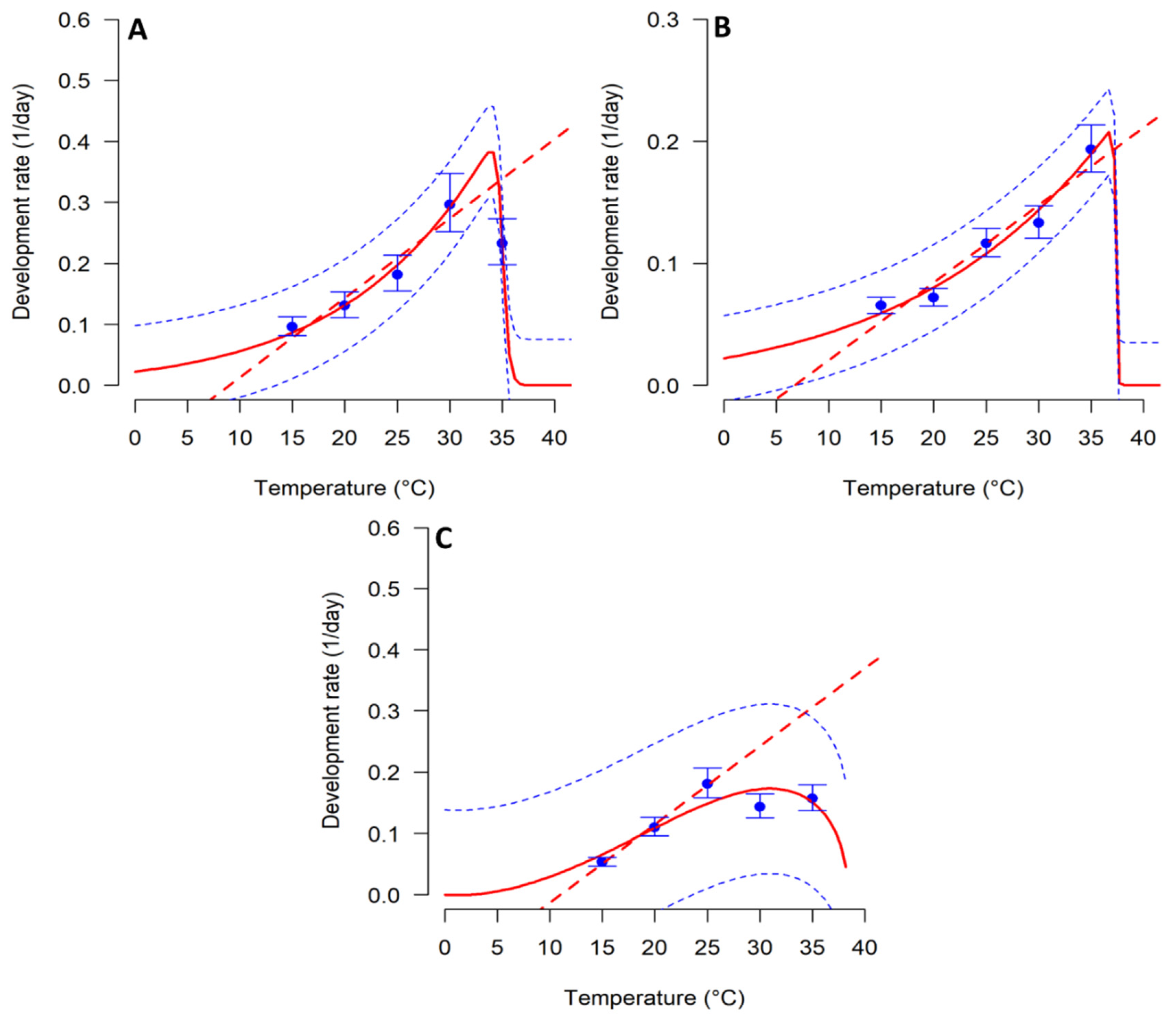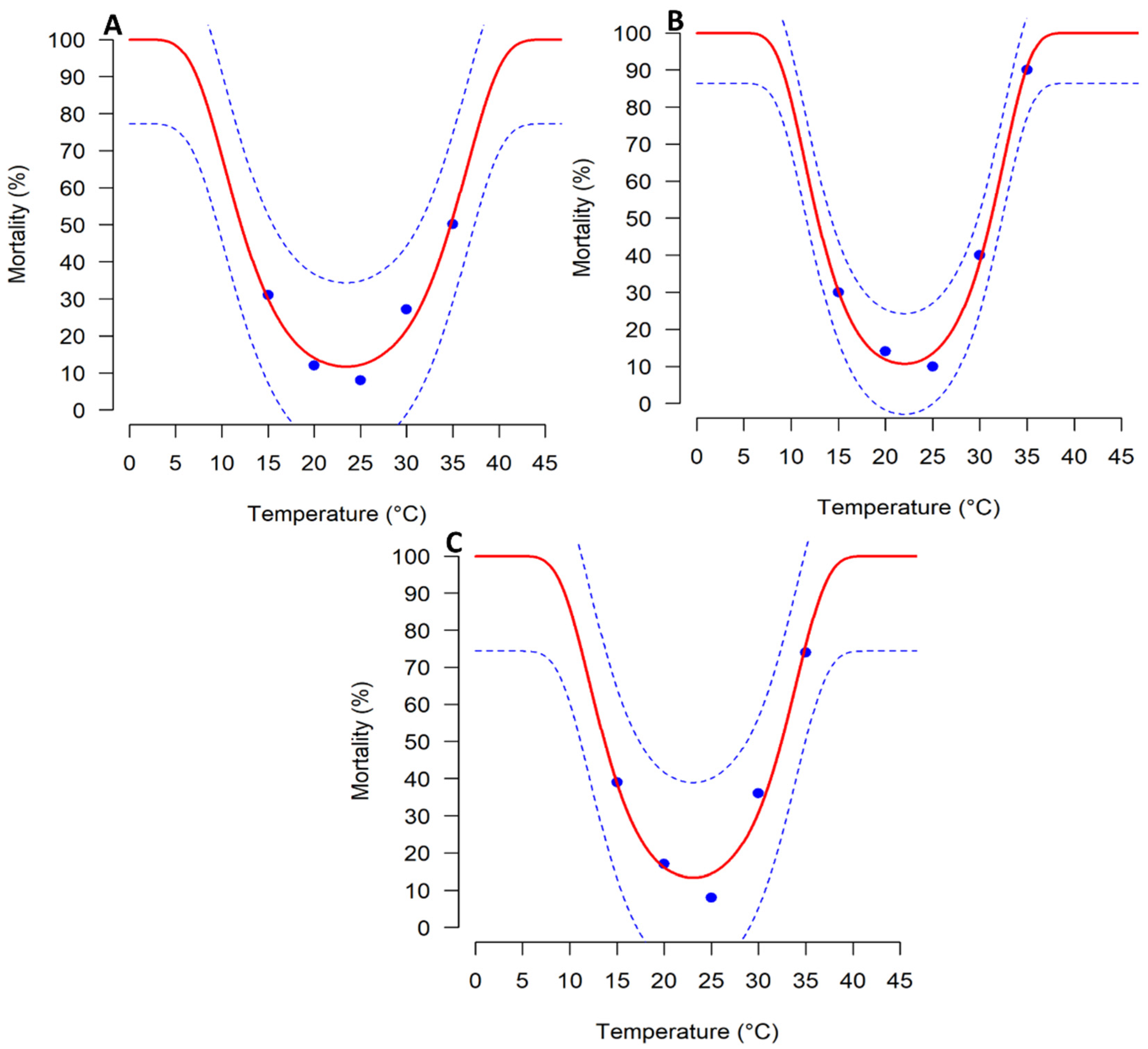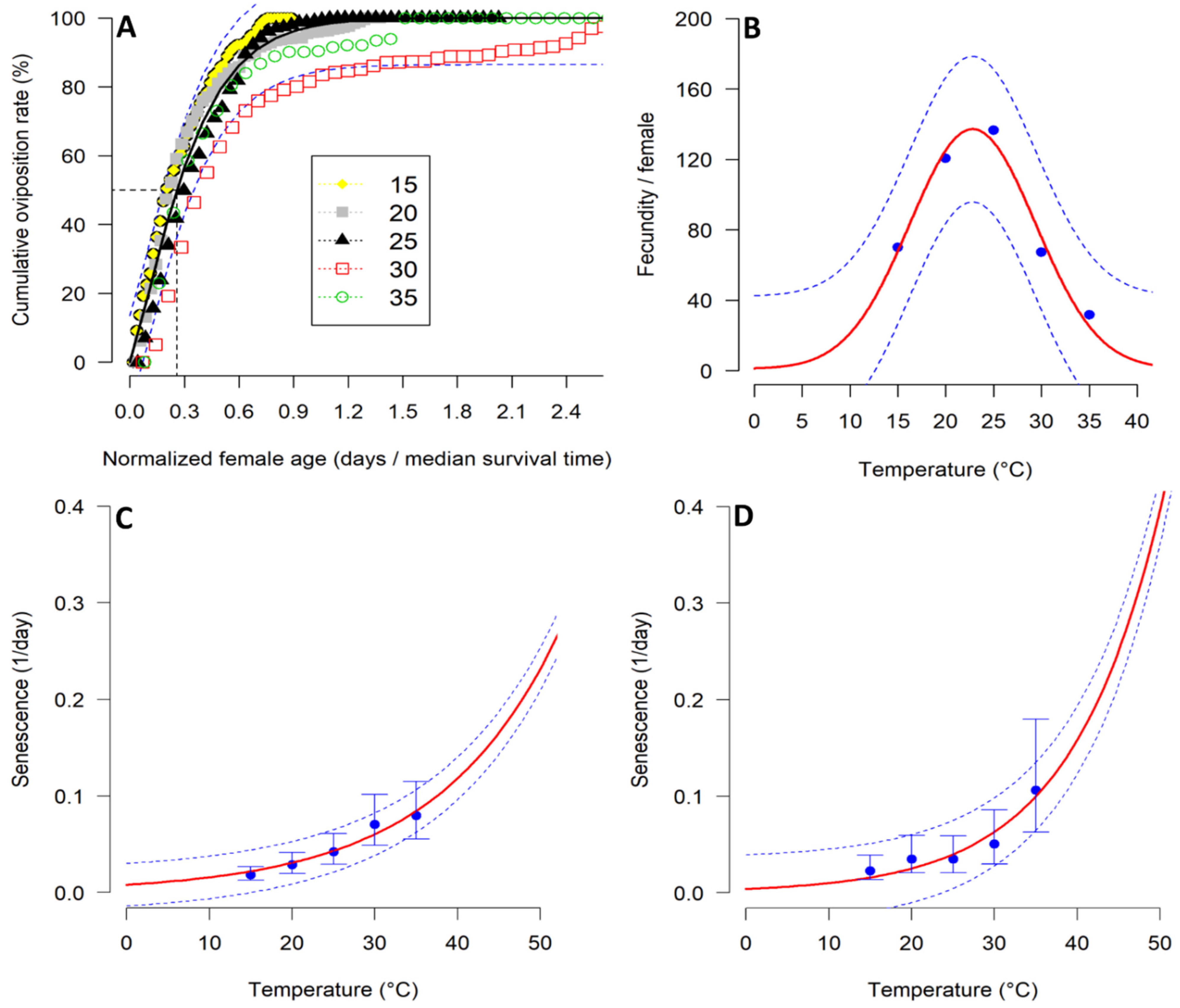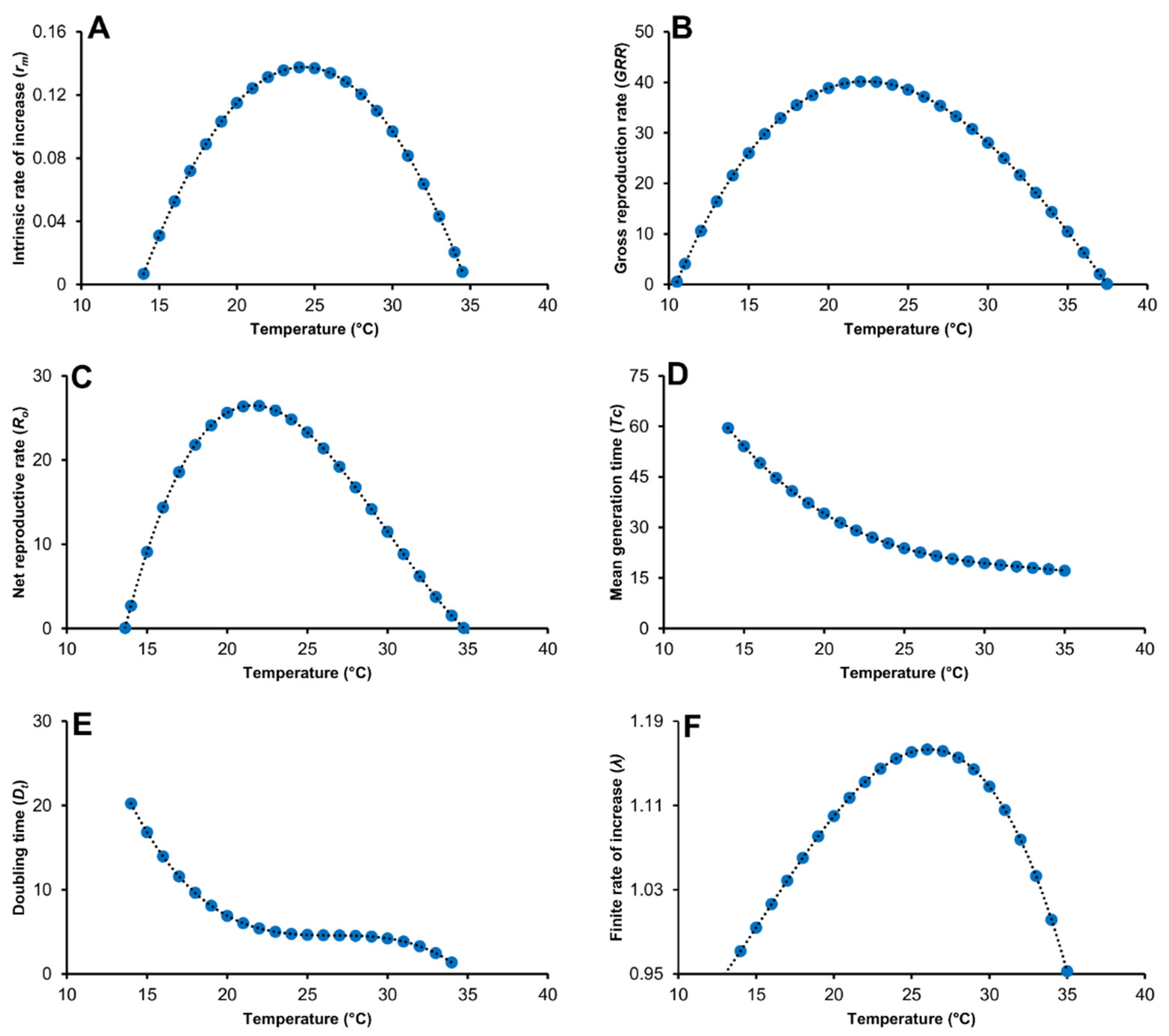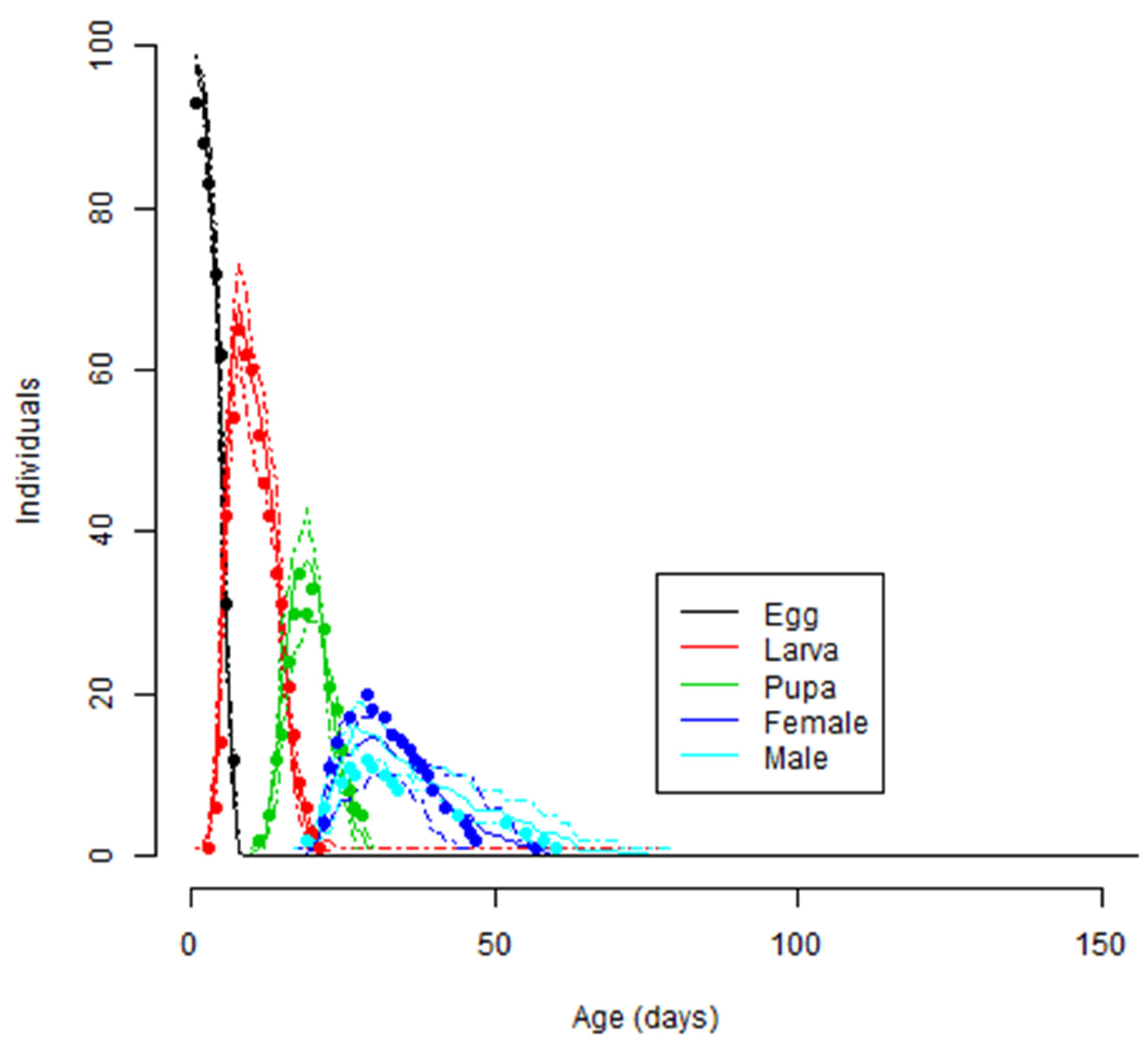1. Introduction
The tomato leaf miner,
Tuta absoluta (Meyrick) (Lepidoptera: Gelechiidae) is one of the most destructive insect pests of tomato and other solanaceous crops worldwide [
1,
2]. The larvae feed on the vegetative parts of tomato plants and fruits, causing yield loss ranging between 80–100% [
3]. Since its trans-Atlantic invasion in 2006,
T. absoluta has spread and established itself in many countries across the Afro-Eurasian Supercontinent [
4,
5,
6]. In Africa,
T. absoluta was detected in Morocco in 2008 and has since then rapidly spread across the continent, causing devastating losses, especially for resource-poor small-scale farmers who could not suppress the pest’s populations [
7,
8]. The high dispersal ability [
9] coupled with its wide thermal range (8 °C and 35 °C) for development [
10,
11], and high reproduction rate [
12] have contributed to the successful invasion and subsequent establishment of
T. absoluta in its new invaded range.
Due to the economic impact of
T. absoluta in the horticultural industry, several attempts have been made to tackle this menace. These include mass trapping using sex pheromones [
13,
14], mating disruption [
15], and agronomic practices, especially the use of field sanitation [
3,
16]. Biological control, using the egg parasitoids
Trichogramma spp., was also used to control
T. absoluta in North Africa [
2]. Similarly, some natural enemies were identified as biological control agents against
T. absoluta in the invaded areas, however, they failed to keep the pest infestation below the economic damage level. For example, two larval parasitoids,
Bracon nigricans Szépligeti (Braconidae) and
Dolichogenidea appellator (Telenga) (Braconidae) were reported to have attacked
T. absoluta in Sudan, however parasitism was too low to effectively manage the pest [
17]. A recent study by Aigbedion-Atalor et al. [
18] revealed the promising performance of the exotic larval parasitoid,
Dolichogenidea gelechiidivoris (Marsh) (Hymenoptera: Braconidae) as a potential classical biological control agent of
T. absoluta in Africa. Nevertheless, all these management options are currently not effective enough to control
T. absoluta. Chemical control using synthetic insecticides remains the main option for the control of this pest [
7]. However, insecticides are not a sustainable management option due to their adverse effects on non-target organisms and the development of pest resistance [
19,
20], as well as adverse effects on both human and environmental health [
21]. Thus, there is a need for the development and adoption of alternative management measures to control
T. absoluta in the horticultural industry. In this regard, the development of novel control strategies of
T. absoluta should incorporate its life-history traits and ecology to effectively manage the pest based on the specific agro-ecological zones.
Considering that insects are poikilothermous, temperature is the most important factor affecting their biology and ecology. Insects’ development, survival, reproduction, population growth, distribution, and population dynamics are temperature-dependent [
22]. Through phenotypic plasticity, insects are able to change their physiological activities and behavior in response to changes in the surrounding environmental conditions [
23,
24]. This plasticity is driven by various physiological factors including enzymes and hormonal regulations that result in local or systemic reactions [
24,
25]. These reactions can be modelled by regressing the values for the phenotypic trait against the environmental factor, a process known as reaction norms [
25]. The reaction norm has been widely used to visualize the responses of life-history traits of different insects against environmental conditions including temperature [
22,
26,
27]. This is an important tool for understanding the phenotypic variation in insects and predicting their distribution and abundance in light of global warming [
28,
29].
The success of invasion and the establishment of alien pests such as
T. absoluta in new environmental conditions is attributed to various factors, among which are the phenotypic plasticity traits that play a vital role in the fitness and survival of the pest [
30]. Several studies have attempted to evaluate the effect of constant temperatures on the development, survival, and reproduction of
T. absoluta [
10,
11,
31,
32,
33,
34,
35]. These studies focused only on predicting the reaction norm for the developmental rate using linear degree-day and non-linear models. However, they did not consider the simulation of the development time, mortality, and fecundity of
T. absoluta that allows for the estimation of the population growth rate. In addition, the developed non-linear models for
T. absoluta immature stage were not validated under a fluctuating temperature to be used in the prediction of distribution and the potential risk of the pest. Therefore, this study aims to investigate the effect of temperature on the development, survival, and reproduction of the Kenyan population of
T. absoluta using linear and non-linear models and to simulate the life table parameters.
4. Discussion
Temperature is known to be the most important environmental factor that affects the development, survival, reproduction, distribution, abundance, and population dynamics of insects [
39,
47]. In this study, we simulate the complete life history traits of
T. absoluta using the phenology modelling approach, unlike other studies that only simulated the development time and rate at constant temperatures [
10,
11,
31,
32,
33], or estimated the life table parameters to determine the population growth rate [
34,
35]. Our results showed that
T. absoluta completed its life cycle at temperatures between 15 °C to 35 °C. However, the response of
T. absoluta life stages to temperature differed, which indicates that the thermal requirements vary between the life stages. The findings of this study provide greater insight into the temperature-dependent development of
T.
absoluta since its invasion of the African continent. In light of global warming, an increase in temperature might induce a shift in the synchrony between the insect pests and their host plants or natural enemies, thus influencing interspecific interactions [
47,
48,
49]. Also, temperature rise is expected to change the distribution, abundance, population dynamics, and range expansion of many insect species with potentially severe consequences for biological invasion [
47,
50]. In this regard, estimation of the thermal requirements and population growth parameters of the pest is very relevant for developing pest management strategies and the prediction of species distributions under climate warming. Therefore, the results obtained in this study could be used to predict the effect of global warming on the invasion risk and distribution of
T. absoluta based on temperature using ILCYM [
47,
51].
Our results for
T.
absoluta egg incubation period (4.3 to 11.6 days) agree with those reported by Bentancourt et al. [
52] and Krechemer and Foerster [
10]. However, the incubation period we obtained at 15 °C was longer than that reported by de Campos et al. [
53] who recorded 9.3 days at the same temperature. In contrast, the development times of larvae at all tested temperatures were much shorter than those reported by Bentancourt et al. [
52], who recorded development times of 11.2 and 29.7 days at 5 and 30 °C, respectively. Contrary to our study, the larval stage did not complete its development at 35 °C as in the study by Bentancourt et al. [
52]. Similarly, de Campos et al. [
53] reported 32.1 days at 15 °C and 10.1 days at 33 °C, which was longer than our findings. This variation in larval development time could be attributed to the differences in the experimental conditions, where de Campos et al. [
53] used relative humidity of 60 ± 5% and photoperiod 16:08 h L:D, while we used 70 ± 5% relative humidity and 12:12 h L:D photoperiod. In addition, the study by de Campos et al. [
53] and Bentancourt et al. [
52] used tomato seedlings grown with fertilizer application, compared to our seedlings that were free from fertilizer application. For example, it has been demonstrated that an increase in nitrogen content in tomato leaves significantly decreases the larval developmental time of the leaf miner
Liriomyza trifolii [
54]. Therefore, the difference in food quality provided for
T. absoluta larvae could be responsible for the observed differences. The development time for the pupa stage was similar to those reported by Krechemer and Foerster [
10] and de Campos et al. [
53].
Temperature-driven models are important tools for predicting the thermal response (reaction norms) of insect development under different climatic regimes. Although insects do not develop at a constant temperature in nature, temperature-driven models provide adequate ecological information such as the thermal thresholds that can be used to predict the pest distribution and population dynamics. For example, the temperature thresholds for pest development obtained from such studies are important for simulating their development under field conditions [
55]. Since control measures against insect pests are more effective in the susceptible life stage, temperature-driven models could predict the phenology of the insect species, identify the vulnerable stage, and also could be used to estimate the timing between control measures and the presence of vulnerable stages of the pest in the field for effective management strategy [
50,
55]. In the present study, we used linear and non-linear models to assess the impact of temperature on life history traits of
T. absoluta. The development rate increased linearly in the temperature range between 15 to 30 °C for egg and larval stages, and between 15 to 25 °C for the pupal stage. This linear trend was similar to those reported by Krechemer and Foerster [
10]; Özgökçe et al. [
33] and de Campos et al. [
53] for the same stages of the pest. The lowest temperature thresholds for egg and larval development were relatively close to those reported by Krechemer and Foerster [
10] who obtained 9.6 °C and 6.7 °C for egg and larva, respectively. However, our findings contrast with those of de Campos et al. [
53], who predicted the minimum temperature threshold for
T. absoluta population from France at 5.7, 5.1, and 5.3 °C for egg, larva, and pupa, respectively. These variations in minimum temperature thresholds may be explained by the fact that
T.
absoluta used in these experiments are from different populations adapted to different climate regions, thus a difference in thermal response is expected.
In the current study, the non-linear Sharpe and DeMichele function [
42] gave the best fit for the egg and larva, while Briere function 1 [
43] was the best-fitted model for the pupal stage. Our study confirms the findings of Rossini et al. [
56] who suggested the Sharpe and DeMichele model as the best function for simulating the development rate of
T. absoluta. The biological importance of this function is that it can forecast the development rate of insects based on the enthalpy of enzyme activation [
42]. Furthermore, the Sharpe and DeMichele function can be fitted in a variety of ways (four, five, six, and seven parameters), making it adaptable to various temperature levels [
41,
57]. On the other hand, the Briere function is one of the non-linear models that have been widely used to predict insect development rates. Unlike the DeMichele function, the Briere function has the ability to estimate all the three temperature thresholds for insect development (minimum, optimum, and maximum temperature thresholds) [
43]. In our study, the non-linear functions estimated the maximum temperature thresholds to be approximately 36, 38, and 38 °C, for egg and larva and pupa, respectively. These thresholds were higher than those reported by Krechemer and Foerster [
10], who predicted the maximum temperature thresholds to be at 35.1, 34.3, and 36 °C, for egg, larva, and pupa, respectively. Similarly, our estimates were different from all models’ outputs fitted by Marchioro et al. [
11]. These differences in thermal requirements could be due to the different
T. absoluta populations as well as the different functions used in the prediction. For example, Krechemer and Foerster [
10] used the Lactin function, while Marchioro et al. [
11] used the Analytics, Briere, Janisch, Lactin, Logan, and Polynomial functions to estimate the thermal thresholds. In general, these variations suggest that
T. absoluta has high thermal plasticity to different climatic conditions. Indeed, a study by Tarusikirwa et al. [
30] revealed that the larval stage of
T. absoluta has high plasticity to the minimum and maximum temperatures. This thermal plasticity is likely one of the contributing factors to the successful invasion in many African countries with different climatic conditions in a short time.
In the present study, the temperature-dependent mortality showed that the mortality rate of
T. absoluta immature stages was higher at extreme temperatures. This is attributed to the fact that the physiological, biochemical, and metabolic reactions of insects are highly influenced by the temperature of their surrounding environment [
48,
58]. The Wang function 1 [
44] predicted the optimum temperature for
T. absoluta immature stages survival between 21 to 23 °C, in which the mortality rate was between 10–13%. This model was also adopted for predicting the mortality of many insects in tropical regions such as the coffee berry borer
Hypothenemus hampei (Ferrari) (Coleoptera: Curculionidae, Scolytinae) and the African coffee white stem borer
Monochamus leuconotus (Pascoe) (Coleoptera: Cerambycidae) [
57,
59], as well as the mealybug
Phenacoccus solenopsis Tinsley (Hemiptera: Pseudococcidae) [
60].
In this study, we obtained average fecundity of 71.1, 120.7, 136.6, 67.4, and 31.8 eggs per female at constant temperatures of 15, 20, 25, 30, and 35 °C, respectively. The fecundity of
T. absoluta was high at temperatures ranging between 20 and 25 °C and sharply decreased at 35 °C. This decline at high temperatures could be due to the short longevity of the female as well to the effect of the high temperature on female’s maturity resulting in low fecundity [
61]. Since the adults we used for fecundity assessment were obtained from pupae formed in the colony, the results we obtained should be interpreted with caution as the rearing of eggs and larvae at ambient conditions (25 ± 2 °C) might have influenced the female oviposition. A study by Mahdi and Doumandji [
31] recorded average fecundity of 122 at 15 °C, which was much higher than our findings at the same temperature. Similarly, the maximum oviposition we obtained (136 eggs per female) was twice lower than that reported by Uchoa-Fernandes et al. [
12] who obtained a maximum fecundity of 260 eggs per female. However, our results were comparable to those reported by Krechemer and Foerster [
10] for the temperature range of 15 to 25 °C, with the number of eggs per female being 76.4, 134.8, 149 at 15, 20, 25, respectively. The fitted Taylor function 1 estimated that
T. absoluta females could lay eggs at a temperature range between 6 and 38 °C, with 22.8 being the optimum temperature for oviposition. The temperature range we reported in the current study is considered fairly wide for a tropical pest, like
T.
absoluta, a trait that may have aided in its adaptability to various agroecological zones across tropical and temperate regions. The thermal range for fecundity we obtained (6 and 38 °C) was different from the report of de Campos et al. [
53], who predicted a thermal window between 5.4 and 35.7 °C using polynomial functions. The differences between the two studies could be explained by the two different models fitted to fecundity, which may result in the estimation of different thermal thresholds. Nevertheless, the results of our model could have been affected by over or underestimated fecundity due to the rearing of early stages (eggs and larvae) of the females at ambient conditions (25 ± 2 °C).
The effect of temperature on bionomics of
T. absoluta has strongly manifested on the life table parameters, such as the intrinsic rate of natural increase (
rm). We reported a negative
rm (−0.065) at 35 °C, which indicates that
T. absoluta population growth is adversely impacted at this temperature. The net reproductive rate (
Ro) we obtained deviated from those reported by de Campos et al. [
53], whereby the authors recorded
Ro between 25.2 and 36.5 at a temperature range of 15–25 °C. This could be attributed to the lower mortality rate of immature stages in the study by de Campos et al. [
53], compared to ours. However, our results were similar to those reported by Martins et al. [
34]. In the present study, the mean generation time ranged between 19 and 54 days, which indicates that
T. absoluta can complete between 6 to 15 generations per year in constant temperatures ranging between 15 and 30 °C.
Since insects do not develop under a constant temperature in their natural habitat, the developed temperature-dependent phenology for
T. absoluta under different constant temperatures experiments was validated using daily fluctuating temperature records. The life table experiment conducted under fluctuating temperatures showed that
T. absoluta has a strong amount of potential to grow its population despite the daily temperature variations, which ranged between 11.6 and 38.6 °C, with a mean annual of 23.1 °C. In this fluctuating temperature range, the
rm was 0.103, with
Ro of 16 daughters per female suggesting a high growth population rate of the pest. In tropical regions, the mean annual temperature ranges between 25 and 30 °C [
62,
63], a conducive environment for
T. absoluta population to rapidly grow and thrive, and this could explain the rapid invasion of the pest in the tropical region. Indeed,
T. absoluta can complete 13 consecutive generations per year under this temperature range depending on the availability of host plants. The comparable outcome of the observed and simulated values we obtained for the development time, mortality, and demographic parameters (such as the intrinsic rate of natural increase) proved that the developed phenology models for
T. absoluta are a best fit for simulating the developmental parameters of the pest. Therefore, these models can be used to predict the impact of global warming in the future distribution and abundance of
T. absoluta.
